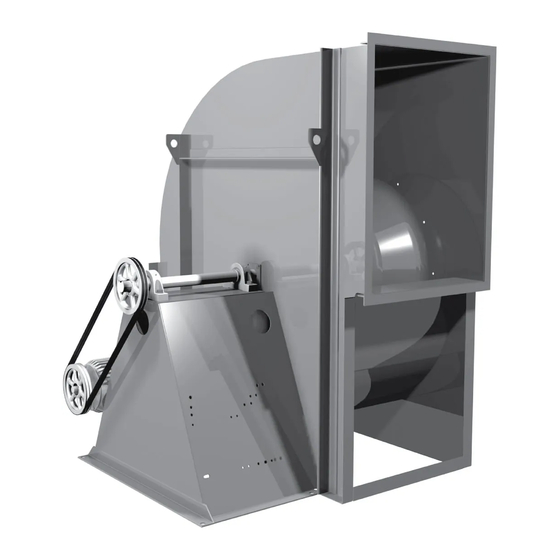COOK CAF-DW 설치, 운영 및 유지보수 매뉴얼 - 페이지 6
{카테고리_이름} COOK CAF-DW에 대한 설치, 운영 및 유지보수 매뉴얼을 온라인으로 검색하거나 PDF를 다운로드하세요. COOK CAF-DW 12 페이지. Centrifugal blowers
COOK CAF-DW에 대해서도 마찬가지입니다: 설치, 운영 및 유지보수 매뉴얼 (17 페이지)

Use of Variable Frequency Drives
Motors
Motors that are to be operated using a Variable
Frequency Drive (VFD) must be VFD compatible. Motors
that are not supplied by Loren Cook Company should have
the recommendation of the motor manufacturer for use
with a VFD.
Grounding
The fan frame, motor and VFD must be connected to a
common earth ground to prevent transient voltages from
damaging rotating elements.
Wiring
Line reactors may be required to reduce over-voltage
spikes in the motors. The motor manufacturer should be
consulted for recommended line impedance and usage of
line reactors or filters if the lead length between the VFD
and the motor exceeds 10 ft (3m).
Fan
It is the responsibility of the installing body to perform
coast-down tests and identify any resonant frequencies
after the equipment is fully installed. These resonant fre-
quencies are to be removed from the operating range of
the fan by using the "skip frequency" function in the VFD
programming. Failure to remove resonant frequencies
from the operating range will decrease the operating life of
the fan and void the warranty.
Inspection
Inspection of the fan should be conducted at the first 30
minute, 8 hour and 24 hour intervals of satisfactory op-
eration. During the inspections, stop the fan and inspect
as per the Conditions Chart.
30 Minute Interval
Inspect bolts, setscrews and motor mounting bolts. Ad-
just and tighten as necessary.
8 Hour Interval
Inspect belt alignment and tension. Adjust and tighten
as necessary.
24 Hour Interval
Inspect belt tension, bolts, setscrews and motor mount-
ing bolts. Adjust and tighten as necessary.
Maintenance
Establish a schedule for inspecting all parts of the fan. The fre-
quency of inspection depends on the operating conditions and
location of the fan.
Inspect fans exhausting corrosive or contaminated air within
the first month of operation. Fans exhausting contaminated air
(airborne abrasives) should be inspected every three months.
Regular inspections are recommended for fans exhausting
non-contaminated air.
It is recommended the following inspections be conduct-
ed twice per year:
• Inspect bolts and setscrews for tightness. Tighten as neces-
sary. Worn setscrews should be replaced immediately
• Inspect belt wear and alignment. Replace worn belts with new
belts and adjust alignment as needed. Refer to Belt and Pulley
Installation
• Bearings should be inspected as recommended in the Lubrica-
tion Conditions Chart
• Inspect variable inlet vanes for freedom of operation and exces-
sive wear. The vane position should agree with the position of
CA/CF/CP IO&M
the control arm. As the variable inlet vanes close, the entering
air should spin in the same direction as the wheel
• Inspect springs and rubber isolators for deterioration and re-
place as needed
• Inspect for cleanliness. Clean exterior surfaces only. Removing
dust and grease on motor housing assures proper motor cool-
ing. Removing dirt from the wheel and housing prevent imbal-
ance and damage
Lubrication
Fan Bearings
Greasable fan bearings are lubricated through a grease
fitting on the bearing.
Lubrication Conditions Chart
Fan Class
Fan Status
Normal Conditions
Centrifugal
(clean, dry & smooth)
Blower
Extreme Conditions
Class I
(dirty/wet/rough)
Normal Conditions
Centrifugal
(clean, dry & smooth)
Blower
Extreme Conditions
Class II
(dirty/wet/rough)
Normal Conditions
Centrifugal
(clean, dry & smooth)
Blower
Extreme Conditions
Class III
(dirty/wet/rough)
Exceptions to the greasing interval chart:
• Periodic Applications (any break of one week or
more): it is recommended that full lubrication be per-
formed prior to each break in operation
• Higher Temperature: it is recommended to halve the in-
tervals for every 30°F increase in operating temperature
above 120°F not to exceed 230°F for standard bearings;
high temperature bearings (optional) can operate up to
400°F
• Vertical Shaft: it is recommended that the intervals
should be halved.
For best results, lubricate the bearing while the fan is in
operation. Pump grease in slowly until a slight bead forms
around the bearing seals. Excessive grease can burst
seals thus reducing bearing life.
Before lubricating, the grease nipple and immediate
vicinity should be thoroughly cleaned without the use of
high pressure equipment. The grease should be supplied
slowly as the bearing rotates until fresh grease slips past
the seal. Excessive pressure should be avoided to prevent
seal damage.
In the event the bearing cannot be seen, use no more
than three injections with a hand-operated grease gun.
NOTICE! Loren Cook Company uses petroleum
lubricant in a lithium base. Other types of grease
should not be used unless the bearings and lines
have been flushed clean. If another type of grease
is used, it should be a lithium-based grease con-
forming to NLGI grade 2 consistency. An NLGI
grade 2 grease is a light viscosity, low-torque,
rust-inhibiting lubricant that is water resistant. Its
temperature range is from -30°F to +200°F and ca-
pable of intermittent highs of +250°F. For temper-
atures above 250°F Mobiltemp SHC 32 is recom-
mended.
6
Maximum Interval
Shaft Size
(operation hrs)
>1-1/2"
10,000
<1-1/2"
2,000
>1-1/2"
2,000
<1-1/2"
400
>2"
7500
<2"
1000
>2"
1500
<2"
200
>2"
3000
<2"
500
>2"
500
<2"
1000
B51181-002
